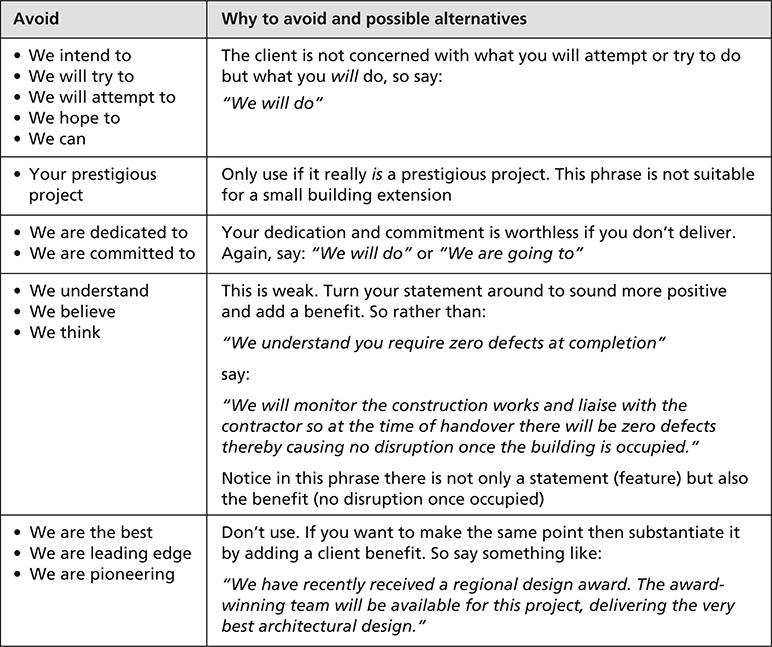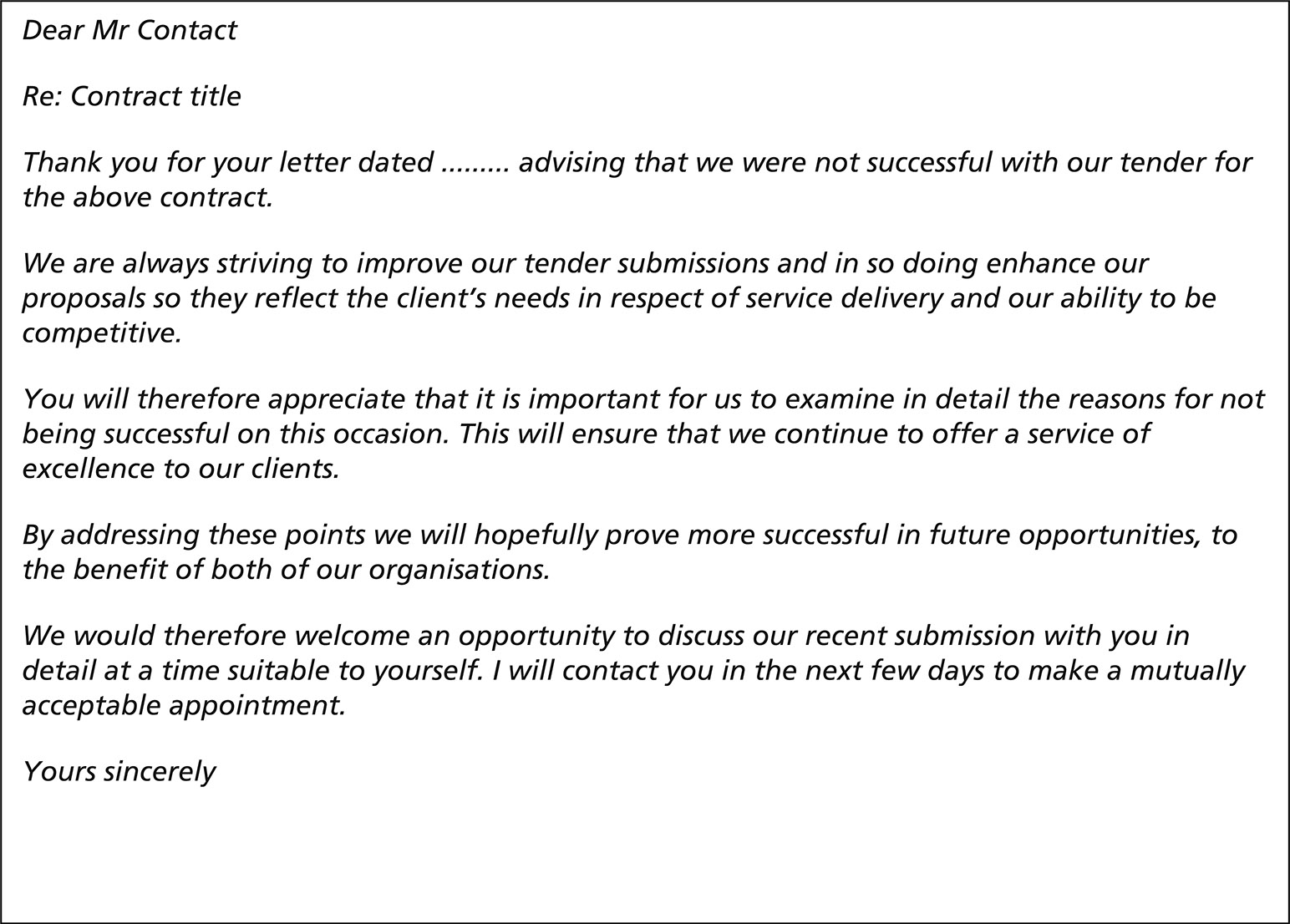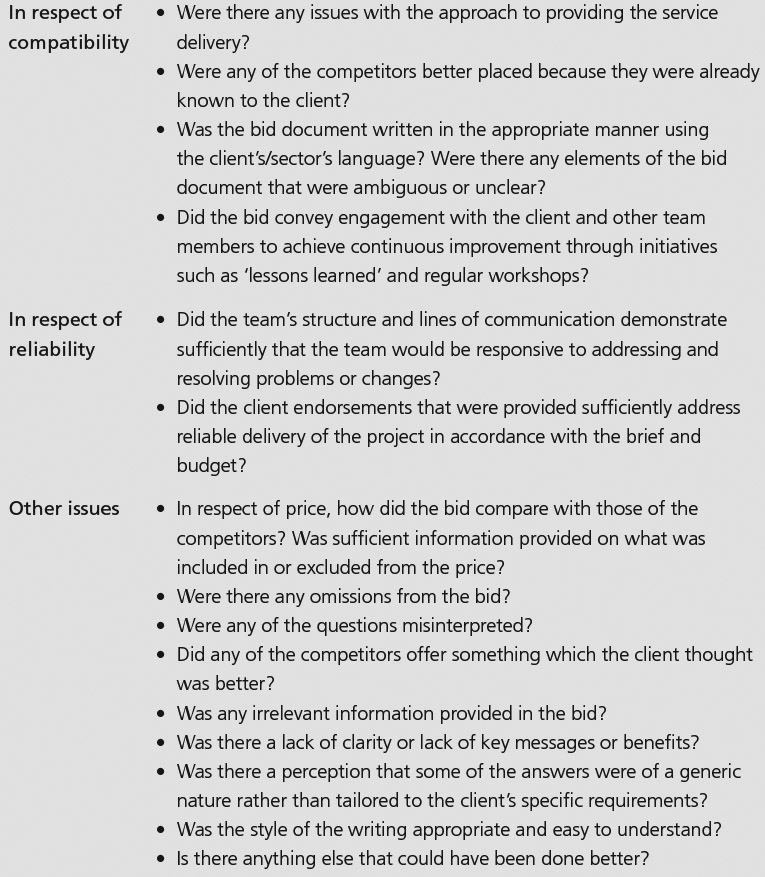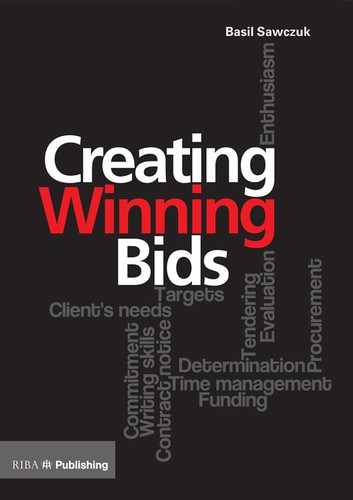Chapter 3
Credibility, capability, compatibility and reliability (the 3Cs + R test)
The 3Cs + R test
When preparing a bid, it is always important to establish the purpose of the questions that are being asked. Ask yourself what the client is trying to find out. Most questions will require you to prove one of the following:
- Credibility (convincing the client that they can believe your claims).
- Capability (convincing the client that you have the experience and adequate resources to undertake the assignment).
- Compatibility (convincing the client that they can work with you and that there is a cultural fit).
- Reliability (convincing the client that you will do what you claim you can do).
Credibility and capability are relatively easy to address. You should be able to prove that you have the appropriate level of experience and that you currently have sufficient resources to undertake the project. The skill lies in really showing off your abilities and making yourself stand out from the competitors.
Compatibility and reliability will take more effort to address and sometimes your qualities in these respects might be examined indirectly rather than directly questioned. So, when preparing your documentation, check that you are able to demonstrate both of these qualities.
When evaluating your submission, the client can make a rational evaluation of your capability, credibility and reliability. This evaluation can be based on examination of your references, endorsements, accreditation, experience and qualifications of your proposed team. Compatibility, however, requires a non-rational evaluation. The client will have to rely on ‘gut instinct’ in determining whether they and their team will be able to work with you and your team.
Credibility
Clients will want to be reassured that they can believe all the claims that you make. To help with this aspect of the bid you should deliver your message with confidence and enthusiasm. Use positive language and refrain from using weak words (see Figure 3.1).

Figure 3.1: Words or phrases to avoid
Another useful tool when writing bids is the use of a presupposition. A presupposition involves using words that give the impression that an idea or experience is presumed without actually saying so. For example:
-
‘Have you now started to win work?’
This presupposes that you have been losing work.
Examples of some phrases that you could introduce in your proposals are:
-
‘This is one of the cost-saving elements of our proposal.’
This assumes that there is more than one cost-saving element.
-
‘Another feature that will deliver distinct benefits is …’
This assumes that there are other features giving distinct benefits.
-
‘Looking at your brief I am sure this will be one of the advantages that will really interest you.’
This assumes that there are several advantages.
To enhance your credibility, have facts and figures at hand to back up your statements.
Rather than saying, ‘We are very experienced in designing schools’, say something like:
- ‘In the past five years we have designed 15 schools, providing facilities for over 6,000 pupils with a total contract value of £75 million.’
In this example, if the project you are bidding for is a school extension to provide a facility for performing arts, then you might wish to say something like:
- ‘In the past five years we have been involved in extending six schools, providing new additional accommodation. Three of these projects incorporated new performing arts facilities. In all cases, the schools continued to function without disruption during construction. In the same period, we were also involved with 15 new schools, providing facilities for 6,000 additional pupils. Five of these schools also had performing arts facilities. Therefore, our total school experience in the past five years includes 21 schools (eight with new performing arts facilities) with a total contract value of £93 million.’
This modified answer has the advantage of:
- placing the most relevant experience first (extending a facility to include performing arts accommodation)
- following up with additional relevant experience, albeit in slightly different circumstances (total of new schools with performing arts facilities)
- including some benefits (no disruption to existing schools during the extension works)
- giving an indication of the total school experience (21 schools with a total contract value of £93 million).
This would also be backed up with several of the most relevant project profiles or case studies.
To build up your credibility you may add additional information that is relevant and might set you apart from competitors. For instance, in the performing arts example above there may be a need for specialist acoustic advice to enhance the acoustics in the auditorium area. This might not have been identified or specified by the client and, by raising the point and offering this specialist additional service within your bid, you may set yourself apart from the competition.
Capability
This is probably the easiest part to prove and is often the area on which most clients, or their advisers, focus. At the very least, you will need to demonstrate the following three aspects:
| Track record | You will have to show that you have undertaken several assignments that are relevant and similar to the project for which you are bidding. Obviously, feature the projects that are the closest match and include other projects that have relevant transferable experience which would be beneficial to the client. |
| Include project sheets, case studies, client references and endorsements. Always, if time permits, rewrite the project sheets and case studies to bring out the relevant information. Also, sequence the information in the appropriate order of priority to reflect the client’s needs. | |
If you do not have exactly the experience being sought, then try to accentuate the following aspects:
|
|
| Technical ability and insight into client’s business and sector | The client will take comfort from knowing that you have relevant sector and building-type experience. Clients do not want to educate their consultants. You will need to show that you not only have that specific knowledge but also that it is up to date and perhaps that you are able to bring added value to the project with the latest thinking and innovation. |
| Application | It is one thing to have the track record and technical ability, but within your bid you will also have to demonstrate how you can adapt to suit the specific client’s needs. By using examples from your other projects, show how your skill and experience resulted in benefits to the clients. |
Compatibility
Most of your competitors will be homing in on the rational criteria, as these are the easiest to demonstrate through project profiles and client endorsements. Because of the effort required, many consultants do not tackle the compatibility angle. This is why clients tend to be more comfortable working with consultants that they have worked with before.
If you have not worked with the client before, it is vital that you try to build up your compatibility credentials during the pre-bid and bidding stages. Some of your competitors will try to give the client a sense of how well they will be able to work together. The smarter professional will seek to give the potential client an insight into how this might operate. This can be achieved by engaging with the client while you are shaping your service delivery within your bid documentation. You should let the client sample your thinking processes and working methods. Familiarity can be built up through an interactive process, so it is important to have laid the foundations of the relationship before the bid documents are issued. This can be achieved by the following actions:
- Defining the client’s needs whenever possible – ask the client for more detail and clarification, but don’t make a nuisance of yourself.
- Defining the problems – try to get the client to elaborate on the thinking behind the needs. What is to be solved and who are the stakeholders that need to be satisfied?
- Exploring the implications of the problem solving – will other issues arise that will need to be addressed?
By having this two-way dialogue with the client you will be able to uncover how the client thinks and evaluates their own needs. You will also, along the way, build up a rapport which may also extend to other decision makers, influencers and stakeholders. This will be a great advantage during the bid evaluation period. Your bid is more likely to receive a favourable evaluation if you are known to the client and have been seen to take an active and thorough interest in the project leading up to the bid.
Depending on the timing and circumstances leading up to the bid process, you may be able to further your compatibility rating with the client by the following means:
- Inviting them to workshops or seminars that will build up your credibility as well as compatibility. These might also include seminars delivered by leading experts in a particular field which are not being organised by you. For example, if your client is in the education sector there might be an educational conference with a speaker talking about how the design of buildings can help to reduce bullying in schools. This approach might work particularly well with public sector clients. They might find it difficult to accept hospitality to, say, sporting events, but could attend a function which is of direct relevance to the project or their work.
- Inviting them to visit one of your projects and meet one of your satisfied clients. There is nothing better than walking around a project and discussing the client’s issues; much invaluable information can be gained from such a visit.
Building on what you learn during this interaction with the client, you will be able to include within the bid submission:
- your process or methodology, which would reflect how the client wants to run the project
- the key issues that may not be highlighted in the bid documentation. Furthermore your client interaction may also give you an indication of the order of priority of the key issues, which can then be reflected in your submission
- the client’s language, idiom or jargon.
It is not always possible to meet the client before the bid documents are received. In this instance, other research needs to be undertaken to give you an insight into the client’s organisation and gain information that you can incorporate into your bid. You can do this by researching the following:
| Annual directors’ report | The key directors of larger client organisations in the private sector will issue an annual report. Elements of the report that may be of particular interest will be the statements about the future growth of the business, which may provide an insight into the need for additional facilities. Also, make a note of any mission, purpose and value statements and examine their corporate responsibility statement. |
| Website | There may be valuable information on the client’s website, which may give you a feel for their approach. Are they driven by money and profit? Are they concerned about sustainability and social responsibility? Are they process and results driven? All these aspects may help you to select the tone and language in your bid documentation. Also, take a look at the news or media section on the website as this will show how the client wants to be perceived within the community. |
| Articles | Some of the larger organisations will have articles written about them or their key individuals. These articles might contain information that you can use. |
As part of the selection process, the bid documents may ask about your approach to working within a team. This may be of particular interest within a framework contract where the client wants to be reassured that the consultants can work together and share relevant experience. The client will look for compatibility within the teams as well as an ethos of sharing good practice and innovative ideas. A typical question found in bid documents is shown in Figure 3.2.

Figure 3.2:
A typical question within a bid document regarding collaborative working
The question in Figure 3.2 is looking for evidence that you have achieved the following:
- passed on good practice from one project to another where you have been involved in a series of projects for a client – this is especially important if several projects are running together using different teams
- been involved in a framework contract involving your competitors, have a process in place to record best practice and demonstrate that you have, in the past, cooperated with your competitors for the benefit of an overall programme of work. This might involve ‘lessons learned’ workshops, monthly meetings with other consultants to share ideas and feedback on projects or a shared website to record information that may be of benefit to other project teams
- demonstrated the ability to be innovative and come up with new ideas that deliver client benefits.
The whole question of compatibility also applies to the team members. This is why clients like to have a team of professionals who have worked successfully together before on similar projects.
Reliability
The other key element that clients will look for is reliability. They want to be reassured that deadlines will be met and that the consultants will be capable of delivering on time. The client will also want to be sure that there will be access to key people should a problem arise and that any such problems will be quickly resolved.
To establish reliability, the client will consult third party endorsements. Therefore, the more recommendations you have from past clients, the better. These will be especially useful if they come from clients in the same sector and relate to projects of similar complexity and value.
To supplement client endorsements, reliability can also be established by case studies and project profiles. These would demonstrate that you have the experience to deliver a service in a reliable way. Clients are, naturally, anxious to avoid being let down. That is why it is often difficult to win an appointment if there is already an incumbent consultant delivering a good service.
To convey your reliability you will need to demonstrate how you:
- monitor progress against a programme of deliverables
- can adapt quickly and accommodate change
- have a clear communications structure within your own team and how you communicate and monitor or control other consultants’ input.
Some bid documents may specifically ask about these aspects but, if they do not and it is appropriate to do so, highlight these points.
Reasons why bids fail and the need to obtain feedback
Given the need to establish credibility, capability, compatibility and reliability, it is important to obtain feedback from clients on your bids, which will have the following benefits:
- providing the opportunity to improve your bid-writing skills since the more bids you submit and the more feedback you obtain, the more quickly you will enhance your technique and therefore your ability to submit winning bids
- gaining a better insight into how bids are evaluated
- possibly obtaining information about your competitors
- showing the client that you are serious about submitting a winning bid. Asking for feedback will also show the client that you are professional in your approach and are sincerely interested in submitting future bids
- advising those who contributed to the bid why the bid failed; this information should be conveyed in a constructive way rather than within a culture of blame.
There is also some benefit in obtaining feedback when you win a bid. There is always room for improvement and the request again shows the client that you are serious about continuous improvement.

Figure 3.3:
Sample letter to the client requesting a feedback meeting
In the case of a bid through an OJEU notice, there is an obligation on the client to give feedback. Therefore request a debrief feedback meeting with the client. Figure 3.3 gives an example of a sample letter to the client requesting a feedback meeting. Private sector clients do not have an obligation to give feedback but, hopefully, if you explain your reasons and the potential benefits to the client, they will accommodate your request.
Many consultants who request a debrief meeting fail to prepare themselves with appropriate questions to ask and so may not uncover the real reasons for failure. The client, or their advisers, may simply offer feedback on the scoring of the bid, but you need to find out more than that.
During the debrief don’t just look for the acceptable reasons for being unsuccessful, such as losing on price. Try to acquire feedback on things that really matter. Unfortunately, the client may not be willing to answer some of the more penetrating questions, at least not directly. Therefore try to explain to the client why you want to know. Let them understand that the feedback is valuable in establishing the appropriate level of service to offer, and possibly being able to provide a better price.
Here are some of the questions you should be asking, based on the key reasons why bids fail:


Careful consideration of any feedback obtained will help to determine if you have a good chance of winning similar projects in the future. If, on reflection, your chances of success are slim or non-existent, due perhaps to a lack of relevant experience, then it would be best to find an alternative opportunity to win work. To help in your decision-making process, it will be useful to employ some form of ‘bid or no bid’ process, as outlined below.
‘Bid or no bid’ decision
You need to focus all your efforts on the winnable bids. Don’t waste your time on the long shots if better opportunities exist. Consider the probability of success and use some form of probability evaluation when following up leads and enquiries.
A good business development programme will have a ‘pipeline’ or a record of leads and enquiries. A lead (sometimes referred to as a prospect) is project specific. It is where an actual project is identified. It is not a client. Clients can generate many leads. A lead is the first stage in the pipeline. The client might not be aware of you at this stage or, if they are, they have not actually asked you to do anything. An enquiry is, again, project specific and occurs when the client has asked you to produce a proposal, price, initial ideas, etc.
As a guide, use probability success rates, where 100 per cent is achieved when a contract is signed. Leading up to this, at the lead stage consider the following levels of probability of success:
- an OJEU notice starts off at only 2 per cent unless you are known to the client and already know about the project
- in respect of other potential clients that don’t know you (but where the prospect is not an OJEU notice), then this should not be more than, say, 10 per cent
- if you are known to the client, then the maximum probability should still be 20 per cent.
Probability of an enquiry being converted into a job:
- In the case of a tender, use statistics. If four competitors are tendering, estimate a 25 per cent probability of conversion unless you believe you have a better or worse chance than the others tendering.
- If nobody else has been asked to submit a proposal then it’s purely the probability of the job going ahead. Start low and raise the probability every time you review the project and it seems to be progressing well. Or lower the probability if the project is not progressing or is likely to be cancelled.
How good is your relationship?
You must also take into account relationship values when considering the probability of success in converting leads to enquiries and enquiries to signed contracts. You might look at simple criteria in evaluating your relationship with the potential client, such as:
- hot (good relationship)
- warm (developing relationship)
- cold (little or no relationship).
Alternatively, expand the relationship classification to suit your requirements.
To assist your ‘bid or no bid’ decision it may be wise to have a checklist. Some of the points to consider are listed below:

Increase your chances of success
Having decided to bid, you can increase your chances of creating a winning proposal by adopting the following measures.
Address the 3Cs + R test
Make sure that, wherever possible, you have given the client the reassurance of knowing that you are credible, capable, compatible and reliable.
Aim to achieve the highest score based on the evaluation criteria
Study the evaluation criteria and make sure that your submission will gain the highest score possible. Don’t skimp on the high-scoring elements. Everything you write must be geared towards addressing the evaluation criteria. If you don’t get the highest score, you don’t win.
Address all the questions that the client may have
Read and reread your submission and see if you need to add any further detail or information to fully address all the questions that the client may have.
Use all the keywords from the client documentation?
You must use the client’s terminology rather than your own. Make sure that every keyword is used and addressed. The evaluator of the proposal will be looking out for these words so make sure you have answered the question thoroughly. Often the evaluator will skim through the response looking out for the keywords. Make sure they are there and easy to find.
Ensure that each section passes the ‘so what?’ test?
Don’t just make statements but take the time to say how they will benefit the client. Ask yourself ‘so what?’ about every statement you make. You need to elaborate and tell the client why the statements are important and how you will bring added value and additional benefits to the project.
Give the client reasons to select you
The client may have several proposals to select from. Have you given them compelling reasons to pick you? This means you really do need to understand what it is that the client wants, which may or may not be directly stated in the client documentation. Having identified the client’s needs, then fully address them and explain how you will be fulfilling them.
▸ Summary Checklist
- Your proposal should satisfy the 3Cs + R test
- Use positive words and phrases
- Use facts and figures to substantiate your claims
- Research the client to make sure you are compatible and are able to demonstrate your compatibility
- Be ruthless in your ‘bid or no bid’ evaluation. Only pursue those opportunities with a good chance of success
- Think twice about submitting a bid when you are not known to the client. Take time to build up a relationship before the bid opportunity arises
- Write your proposals to specifically address the evaluation criteria. Aim to score high marks on each section
